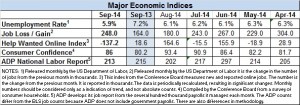Temp agencies continue to play a key role in creating new jobs, contributing 19,400 to September’s surprisingly strong 248,000.
This morning’s jobs report from the Bureau of Labor Statistics showed hiring was strong across a number of sectors in September, which helped push down the unemployment rate to a six-year-low of 5.9%. The report also adjusted upward the Bureau’s counts of hiring in August and July, increasing both by a combined 69,000 jobs. August’s initial anemic 142,000 estimate, which surprised analysts and prompted worrying about a hiring pause, was upped to 180,000.
Today’s announcement was a more pleasant surprise.
Economists predicted September’s numbers would be in the 215,000 to 220,000 range. The significantly higher number, plus the substantial upward revisions, signals that the August slowdown — only the second time this year hiring was under 200,000 — was a blip.
“The slower gain initially reported for August now appears to have been simply an aberration,” said Gad Levanon, director of macroeconomic and labor-market research at the Conference Board.
While retailers, healthcare, and the leisure and hospitality sectors were among the leaders in adding jobs last month, temp agencies have contributed an average of 18,000 new workers each month since the beginning of the year.
Employment by temp agencies reached 2.93 million in September, an 8.6% increase since September 2013. Total nonfarm employment, as reported by the BLS, has grown less than 2% during that same period.
In addition, executive search firms — whether retained or contingent — have been adding workers to their payrolls. In July, the last month for which numbers are available, the BLS said there 42,000 employees on search firm payrolls. In July 2013, search firms had 37,500 employees.
September’s job growth, according to the BLS report, was concentrated in the service sector. Retailers and the leisure and  hospitality industry added 35,300 and 33,000 jobs respectively. Grocers added 19,500 jobs, most of them marking the return to work of New England’s striking Market Basket employees. Restaurants and bars hired 20,400 new workers.
hospitality industry added 35,300 and 33,000 jobs respectively. Grocers added 19,500 jobs, most of them marking the return to work of New England’s striking Market Basket employees. Restaurants and bars hired 20,400 new workers.
Other sectors showing hiring strength:
- Healthcare, up 22,600, the bulk coming from home health care and outpatient facilities;
- Professional and technical services, including jobs for architects and engineers, software developers and management and technical consultants, added 21,100 jobs;
- The financial sector, among the hardest hit by the recession, added 12,000 jobs.
Goods producers added only 29,000 jobs, with manufacturing contributing 4,000 and construction adding 16,000. Mining added 9,000.
Wages and the length of the workweek changed little in September. Wage growth has been mostly stagnant this year, with hourly pay rates rising only 2 percent. The average workweek for all employees on private nonfarm payrolls was 34.6 hours in September.
The BLS report also showed participation in the labor force is continuing to contract, which is a factor in brining down the unemployment rate. September’s rate of 62.7 percent was the lowest since 1978. Even if no new jobs were being created, the unemployment rate would be decreasing since there are fewer workers employed or looking for work.
